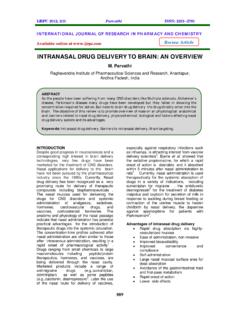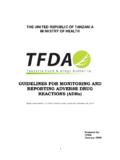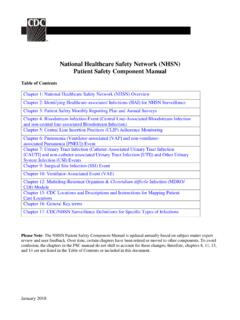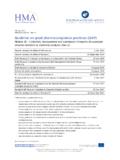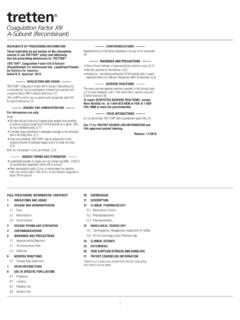Transcription of ADVERSE DRUG REACTION-CAUSALITY ASSESSMENT
1 IJRPC 2011, 1(3) Srinivasan et al. ISSN: 2231 2781 606 INTERNATIONAL JOURNAL OF RESEARCH IN PHARMACY AND CHEMISTRY Available online at ADVERSE drug REACTION-CAUSALITY ASSESSMENT Srinivasan R* and Ramya G PES College of Pharmacy, Department of Pharmacy Practice, 50 Ft. Road, Hanumanth Nager, Bangalore, Karnataka, India. *Corresponding Author: INTRODUCTION ADVERSE drug reactions (ADRs) are considered as one among the leading causes of morbidity and mortality1..The epidemiological importance of ADR is justified by its high prevalence rate they cause from 3% to 6% of hospital admissions at any age, and up to 24% in the elderly population; they rank fifth among all causes of death and, moreover, they represent from 5 to 10% of hospital costs2.
2 And is a great cause of concern to the medical profession. Every occasion when a patient is exposed to a medical product, is a unique situation and we can never be certain about what might happen. A good example for this is thalidomide tragedy in late 1950s and prescribed as a safe hypnotic to many thousands of pregnant women caused severe form of limb abnormality known as phocomelia in many of the babies born to those women. It was a seminal event that led to the development of modern drug regulations aimed to identify, confirm and quantify ADRs. An ADVERSE drug reaction (ADR) is any undesirable effect of a drug beyond anticipated therapeutic effects occurring during clinical use14.
3 Hence every health care professional who give advice to patients need to know the frequency and magnitude of the risks involved in medical treatment along with its beneficial effects. Recent epidemiological studies estimated that ADRs are fourth to sixth leading cause of death3. It has been estimated that approximately of all hospital admission are caused by ADRs and as many as 35% of hospitalised patients experience an ADR during their hospital stay4. An incidence of fatal ADRs is 5 Although many of the ADRs are relatively mild and disappear when drug is stopped or dose is reduced, others are more serious and last longer.
4 Therefore there is a little doubt that ADRs increase not only morbidity and mortality but also add to the overall health care cost 6, 7. ADVERSE drug reaction (ADR) Definitions of ADRs exist, including those of the World Health Organization (WHO)8. Karch and Lasagna9 and the Food and drug Administration (FDA)10. WHO Any response to a drug which is noxious and unintended, and which occurs at doses normally used in man for prophylaxis, diagnosis, or therapy of disease, or for the modification of physiological function. Karch and Lasagna Any response to a drug that is noxious and unintended, and that occurs at doses used in humans for prophylaxis, diagnosis, or therapy, excluding failure to accomplish the intended purpose.
5 FDA For reporting purposes, FDA categorizes a serious ADVERSE event (events relating to drugs or devices) as one in which the patient outcome is death, life-threatening (real risk of dying), hospitalization (initial or prolonged), disability (significant, persistent, or permanent), congenital anomaly, or required intervention to prevent permanent impairment or damage. Classification of ADVERSE drug reactions ADRs can be divided schematically into two major categories: Review Article IJRPC 2011, 1(3) Srinivasan et al. ISSN: 2231 2781 607 Type A and Type B (Table 1). Type A reactions are common, predictable and may occur in any individual.
6 Type B ADRs are uncommon and unpredictable and only occur in susceptible individuals 11. Type A reactions are the most frequent and can be observed in as many as 25 45% of patients. These represent an exaggeration of the known primary and/or secondary pharmacological actions of the drug , they are dose related and could probably be avoided and/or foreseen12. Multi-factorial, involving not only defects at multiple gene loci but also environmental factors such as concomitant infections. Most work has focused on enzyme polymorphism in drug oxidation and conjugation as risk factors for drug toxicity but genes involved in cell repair mechanisms, elaboration of cytokines and immune responsiveness cannot be excluded to predict individual susceptibility to different forms of ADRs12, Genetic polymorphisms are a source of variation of drug response in the human body.
7 In relation to ADRs, most interest has centred on the involvement of pharmacokinetic factors and, in particular, drug metabolism. However, there is now increasing realization that genetic variation in drug targets (Pharmacodynamic factors) might also predispose to ADRs, although research into this area is in its infancy15. Mechanism by which ADR Occurs 16 ADRs can be classified as either pharmacological reactions representing an augmentation of the known pharmacological actions of the drug or idiosyncratic reactions that are not predictable. Pharmacological reactions are most common, usually dose-related and are due to the primary or secondary pharmacological characteristics of the drug .
8 Factors that predispose to these ADRs include dose, pharmaceutical variation in drug formulation, pharmacokinetic or pharmacodynamic abnormalities, and drug - drug interactions. Pharmacological ADRs occur when drug concentration in plasma or tissue exceeds the therapeutic window or when there is increased sensitivity to the drug (even in concentrations considered normal for the general population). Idiosyncratic ADRs are less common, often serious, not dose dependent and show no simple relationship between the dose and the occurrence of toxicity or the severity of the reaction.
9 The toxic reactions may affect many organ systems either in isolation or combination. The mechanism of these is not clear but is thought to include receptor abnormality, abnormality of a biological system that is unmasked by the drug , immunological response, drug - drug interactions, or be multi-factorial. ADVERSE drug reaction (ADR) monitoring involves following steps 1. Identifying ADVERSE drug reaction (ADR). 2. Assessing causality between drug and suspected reaction by using various algorithms. 3. Documentation of ADR in patient s medical records. 4. Reporting serious ADRs to pharmacovigilance centres /ADR regulating authorities Identifying the ADVERSE drug Reaction The ADRs produced by a certain new drug are often recognized when the medication is undergoing its phase three randomized controlled trials.
10 Both in the USA and in the UK there is post marketing surveillance of ADRs. In the UK this involves reporting suspected ADRs to the Commission on Human Medicine using the yellow card system. In this system new or intensively monitored medicines should have all suspected ADRs reported and other medicines should have any suspected serious ADR reported. In spite of these mechanisms ADRs are vastly under reported,17 and initial reports of ADVERSE reactions to drugs have taken up to seven years for trends to begin to appear in the literature. Under reporting of ADRs is likely to be due to a number of reasons.





